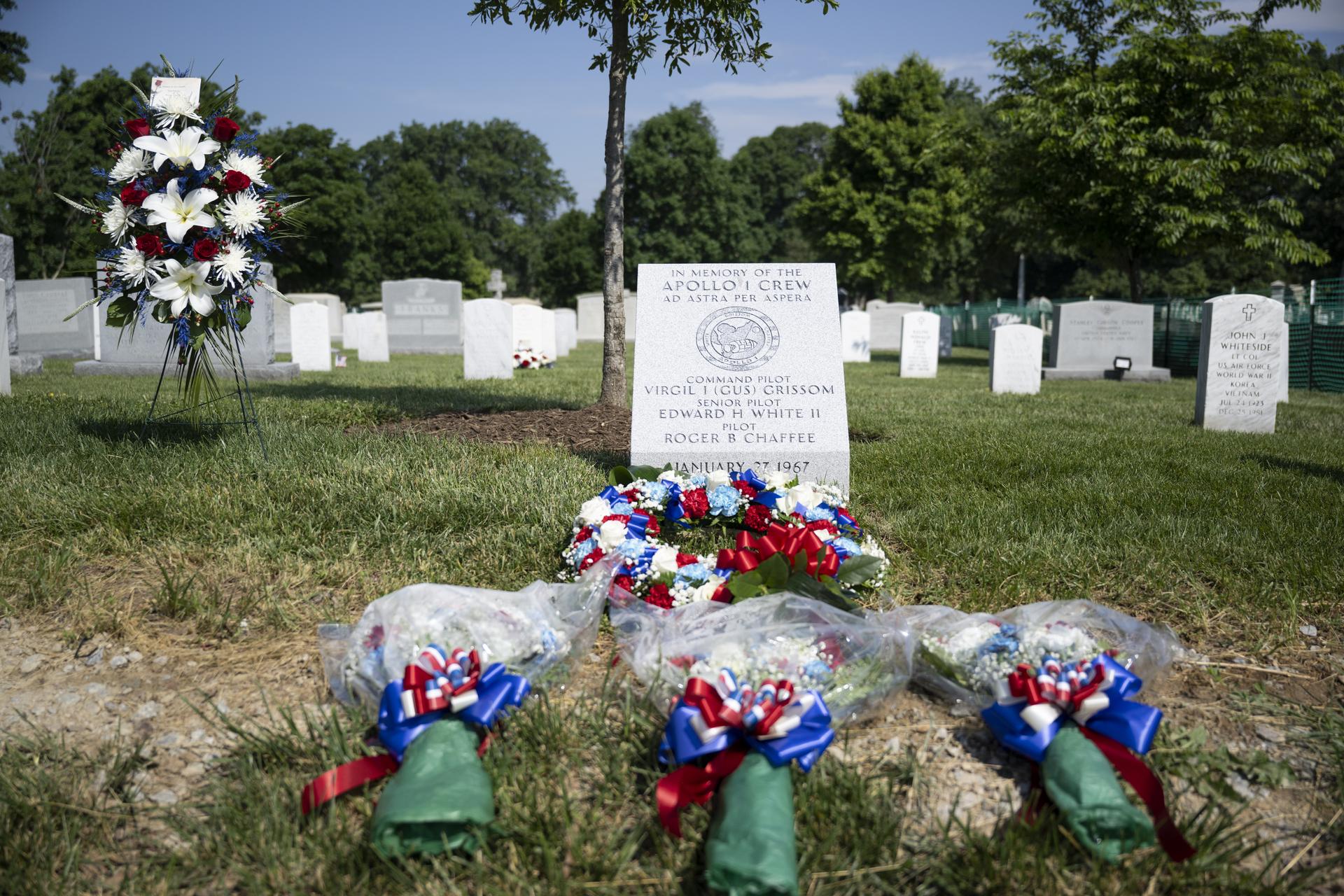Astronauts
- Michael P. Anderson, Section 46, site 1180-1. Anderson was a mission specialist on STS-89, the eighth Shuttle-Mir docking mission and the payload commander on STS-107, a dedicated science mission. Anderson died with his crewmates when STS-107 broke up on re-entry.
- Charles A. Bassett, Section 4, site 195. An Air Force veteran, Bassett had been selected to be the pilot of the Gemini IX mission when he died in a plane crash in St. Louis in 1966.
- Alan L. Bean, Section 11, site 249-2-B. A Navy veteran and artist, Bean was the lunar module pilot on Apollo 12 (1969) and spacecraft commander on Skylab II (1973).
- David Brown, Section 46, site 1180-3. Brown was a mission specialist on STS-107, a dedicated science mission, which broke up on re-entry, killing the crew.
- Roger B. Chaffee, Section 3, site 2502-F. A naval aviator selected as a NASA astronaut in 1963, Chaffee died in the 1967 Apollo 1 fire.
- Laurel Blair Salton Clark, Section 46, site 1180-2. A Navy veteran, Clark was a mission specialist aboard STS-107 (2003), a dedicated science mission that broke up on re-entry, killing the crew.
- Charles (Pete) Conrad, Section 11, site 113-3. Conrad flew aboard Gemini V (1965) and commanded Gemini XI (1966), Apollo 12 (1969) (the second moon landing), and Skylab I (1973).
- Donn F. Eisele, Section 3, site 2503-G-1. An Air Force test pilot, Eisele flew aboard Apollo 7 (1967), the first flight of the Apollo spacecraft.
- Theodore C. Freeman, Section 4, site 3148-LH. A Navy veteran and member of the third astronaut class, Freeman died during a training flight in 1964.
- C. Gordon Fullerton, Section 46, site 670. Fullerton flew on two space shuttle missions, STS-3 and STS-51F, in the 1980s but spent most of his career as a test pilot. He retired from NASA in 2007 as the associate director of flight operations at NASA’s Dryden Flight Research Center (now the Armstrong Flight Research Center).
- John Glenn, Section 35, site 1543. A decorated Marine pilot during World War II and the Korean War, Glenn was one of the original Mercury 7 astronauts. He became the first American to orbit the Earth, aboard Friendship 7 (1962), and returned to space in 1998 as a payload specialist on STS-95.
- Richard Gordon, Section 18, site 30047. A U.S. Navy pilot, Gordon flew on Gemini XI in 1966 and was the command module pilot on Apollo XII, the second lunar landing (1969).
- S. David Griggs, Section 7-A, site 81. A naval aviator, Griggs was a mission specialist aboard space shuttle mission STS-51D (1985).
- Virgil I. (Gus) Grissom, Section 3, site 2503-E. One of the original Mercury 7 astronauts, Grissom was the second American to fly in space, aboard Liberty Bell 7. He commanded the first Gemini flight, Gemini III, and was scheduled to command the first Apollo mission. He died in the 1967 Apollo 1 fire.
- Henry W. Hartsfield Jr, Section 46, site 1074. Hartsfield was the pilot of space shuttle mission STS-4 (1982) and commanded space shuttle missions STS-41D (1984) and STS-61A (1985).
- James Benson Irwin, Section 3, site 2503-G-2. An Air Force test pilot, Irwin was the lunar module pilot on the Apollo 15 mission.
- Robert F. Overmyer, Section 23, site 22469. Overmyer was the pilot of space shuttle mission STS-5 (1982) and commanded space shuttle mission STS-51B (1985).
- Stuart A. Roosa, Section 7A, Site 73. An Air Force test pilot, Roosa served as command module pilot of Apollo 14 (1971).
- Francis R. (Dick) Scobee, Section 46, site 1129-4. Scobee was the pilot of space shuttle mission STS-41C (1984) and commanded space shuttle mission STS-51L (1986), which was lost shortly after launch.
- Elliot Mckay See Jr, Section 4, site 208. See had been named commander of Gemini IX when he died with Charles Bassett in a plane crash in 1966.
- Michael J. Smith, Section 7A, site 208-1. Smith was the pilot of space shuttle mission STS-51L, which was lost shortly after launch in 1986.
- Stephen Thorne, Section 7A, site 135. Thorne was an astronaut candidate when he died in a plane crash in 1986.
- David M. Walker, Section 66, site 5191. Walker was the pilot on space shuttle mission STS-51A and commanded the space shuttle missions STS-30, STS-53, and STS-69.
- Clifton C. Williams Jr, Section 3, site 2503-H-1. A naval aviator and U.S. Marine, Williams died in a training flight in 1967 before he could fly in space.
Executives
- James E. Webb, Section 2, site 961-G. Webb was the second NASA administrator, serving from February 1961 through October 1968.
- Michael F. “Obie” O’Brien, Section 8A, site 379. A former Naval pilot, O’Brien worked at NASA for 21 years, retiring as the head of the office that managed the agency’s international and interagency relations.
Memorials
- Apollo 1, Section 3
- Space Shuttle Challenger (STS-51-L), Section 46
- Space Shuttle Columbia (STS-107), Section 46






























